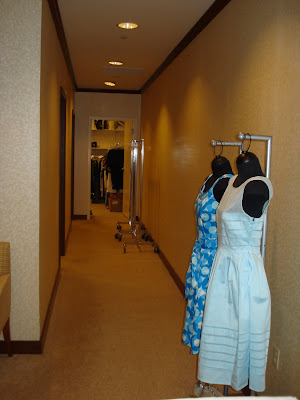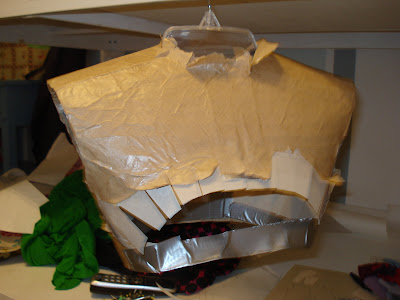




a Way into Narnia



 This was not actually my desk. But I would sit here on occasion if I had a new client and wanted to familiarize them with the service.
This was not actually my desk. But I would sit here on occasion if I had a new client and wanted to familiarize them with the service. Every quarter a different vendor would pay us to merchandise these two forms. We would change out the clothes about every three weeks. . . except with Calvin Klein. . . which is what you see below. Our store didn't really carry Calvin Klein so it was tough to find new merchandise. We did carry a few dresses so we had to make do with them for 3 months. I would change out the shoes and handbags though. BTW - Calvin Klein shoes, especially anything that has a platform, are the most comfortable shoes out there. I could wear 5" heels for 12 hours if I needed to and my feet would still feel fine! I have 4 pairs of the same pair of shoe. . . which I have no occasion to wear anymore.
Every quarter a different vendor would pay us to merchandise these two forms. We would change out the clothes about every three weeks. . . except with Calvin Klein. . . which is what you see below. Our store didn't really carry Calvin Klein so it was tough to find new merchandise. We did carry a few dresses so we had to make do with them for 3 months. I would change out the shoes and handbags though. BTW - Calvin Klein shoes, especially anything that has a platform, are the most comfortable shoes out there. I could wear 5" heels for 12 hours if I needed to and my feet would still feel fine! I have 4 pairs of the same pair of shoe. . . which I have no occasion to wear anymore.

 This is the hallway going from the main office back to my office. There are two large fitting rooms along the way.
This is the hallway going from the main office back to my office. There are two large fitting rooms along the way. This is what you would see once you walked down the hallway. . . this was my office and the area where we did gift wrap, held customer goods and ran up sales. It's not quite as glamorous. You also didn't get walk in sales when you were stuck in the back.
This is what you would see once you walked down the hallway. . . this was my office and the area where we did gift wrap, held customer goods and ran up sales. It's not quite as glamorous. You also didn't get walk in sales when you were stuck in the back.  This room seems like it was always a mess despite all my efforts to keep it clean. It's funny, at work I was the opposite of how I am at home. . . I cleaned all the time.
This room seems like it was always a mess despite all my efforts to keep it clean. It's funny, at work I was the opposite of how I am at home. . . I cleaned all the time.

For more than 1,000 years, the Hohokam peoples occupied the land that would become Phoenix.[7] The Hohokam created roughly 135 miles (217 km) of irrigation canals, making the desert land arable. Paths of these canals would later become used for the modern Arizona Canal, Central Arizona Project Canal, and the Hayden-Rhodes Aqueduct. The Hohokam also carried out extensive trade with nearby Anasazi, Mogollon, and other Mesoamerican tribes.
It is believed that, between 1300 and 1450, periods of drought and severe floods led to the Hohokam’s abandonment of the area.American and European "Mountain Men" likely came through the area while exploring what is now central Arizona during the early 19th century. They obtained valuable American Beaver and North American River Otter pelts; these animals, as well as deer and Mexican Wolves, often lived in the Salt River Valley when water supplies and temperatures allowed.
The US Army created Fort McDowell on the Verde River in 1865 to quell Native American uprisings. Hispanic workers serving the fort established a camp on the south side of the Salt River by 1866 that was the first permanent settlement in the valley after the decline of the Hohokam.A Prisoner of War Camp was established at the site of what is now Papago Park and Phoenix Zoo for the internment of German soldiers captured in Europe.[19] In 1944, dozens of prisoners had devised a plan to escape from the camp and use boats to go down the nearby Salt River to reach Mexico. However, they were unaware that the river was mostly dry had not been navigable for decades, and were thus easily apprehended near the camp.
A fire in October 1947 destroyed most of the streetcar fleet, making the city choose between implementing a new street railway system or using buses. The latter were selected, and automobiles remained the city’s preferred method of transportation.
This part makes me really sad. It would have been so nice to have a streetcar system set up all over this sprawling metropolis.
By 1950, over 100,000 people lived within the city and thousands more in surrounding communities. There were 148 miles (238 km) of paved streets and 163 miles (262 km) of unpaved streets.
Apparently between 1950 and today over 1,000,000 people moved to the city of Phoenix alone and no one seems to know why . . . I couldn't find anything about the last 60 years. My guess is tourism brought people here and created a demand for jobs. The climate allowed for the play and training of sports year round and the winters are fabulous!











 I would like to do this project again sometime with different measurements. I would extend the project over a period of about a week. I needed to finish this today, so I did not allow the glue to dry all the way which led to the form warping when I took the stays out from the inside and stuffed it with polyfil. As a result one of the shoulders appears higher and the waist doesn't seem to go in as far on one side. All in all I'm not too upset with the results from my first attempt.
I would like to do this project again sometime with different measurements. I would extend the project over a period of about a week. I needed to finish this today, so I did not allow the glue to dry all the way which led to the form warping when I took the stays out from the inside and stuffed it with polyfil. As a result one of the shoulders appears higher and the waist doesn't seem to go in as far on one side. All in all I'm not too upset with the results from my first attempt.


